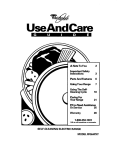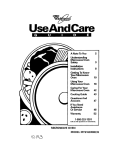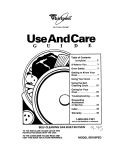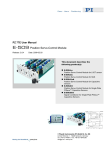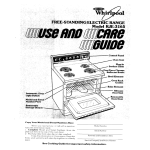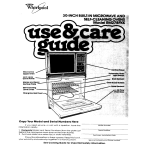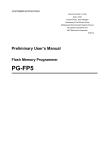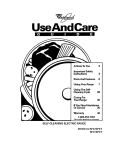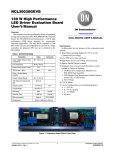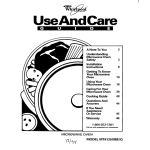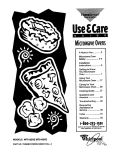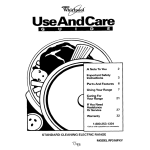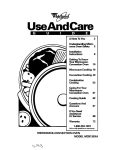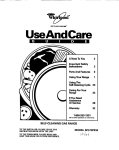Download Whirlpool RB770PXY Specifications
Transcript
. TilL w ol’ d@ UseAndCam \\ A Note To You 2 Important Safety Instnxtions 3 Parts And Features 5 Using Your Oven 7 !Z%!tZing Cycle 26 Carin For Your 8v en 32 If You Need Assistance Or Setvice 37 Warranty 40 1-600-253-1301 Call ua with quedons or comments. SELF-CLEANING ELECTRIC BUILT-IN SINGLE AND DOUBLE OVENS MODELS RB770PXY RB760PXY RB270PXY RB260PXY RB17OPXY RBIGOPXY A Note To You Thank you for buying a Whirlpool appliance. You have purchased a quality, worldclass home appliance. Years of engineering experience have gone into its manufacturing. To ensure that you will enjoy many years of trouble-free operation, we have developed this Use and Care Guide. lt is full of valuable information on how to operate and maintain your appliance properly and safely. Please read it carefully. Also, please complete and mail the Ownership Registration Card provided with your appliance. This will help us notify you about any new information on your appliance. Your safety is important to us. This guide contains safety symbols and statements. Please pay special attention to these symbols and follow any instructions given. Here is a brief explanation of the use of each symbol. This symbol will help alert you to such dangers as personal injury, burns, fire and electrical shock. This symbol will help you avoid actions which could cause product damage (scratches, dents, etc.) and damage to your personal property. Our Consumer Assistance Center is toll-free, 24 hours a day. number, l-800-253-1301, If you ever have a question concerning your appliance’s operation, or if you need service, first see “If You Need Assistance Or Service” on page 37. If you need further help, feel free to call our Consumer Assistance Center. When calling, you will need to know your appliance’s complete model number and serial number. You can find this information on the model and serial number plate (see diagram on page 5). For your convenience, we have included a handy place below for you to record these numbers, the purchase date from the sales slip and your dealer’s name and telephone number. Keep this book and the sales slip together in a safe place for future reference. Model Number Dealer Name Serial Number Dealer Phone Purchase 2 Date General l Read all instructions before using the oven. l Install or locate the oven only in accordance with the provided Installation Instructions. The oven must be installed by a qualified installer. The oven must be roperly connected to electrica Psupply and grounded. l CAUTION: Do not store things children mi ht want above the oven. Chil 2 ren could be burned or injured while climbing on it. l Do not leave children alone or unattended in area where the oven is in use. They should never be allowed to sit or stand on an part of the oven. They could ‘be burned or injured. l Do not operate the oven if it is damaged or not working properly. l Do not use the oven for warming or heatin the room. Persons could be %umed or injured, or a fire could start. l Use the oven onl for its intended use as CT escribed in this manual. l l l l Do not touch heating elements or interior surfaces of oven. Heating elements may be hot even though they are dark in color. Interior surfaces of an oven become hot enough to cause burns. During and after use, do not touch, or let clothing or other flammable materials contact heatin elements or interior surfaces 03 oven until they have had sufficient time to cool. Other surfaces of the oven may become hot enough to cause bums: such as, the oven vent opening, the surface near the vent opening, the oven door and window. Do not wear loose or hanging arments when usin the oven. s hey could ignite if t I?ey touch a hot heating element and you could be burned. Use only d potholders. Moist or damp po7 holders on hot surfaces ma result in burns from steam. b 0 not let potholder touch hot heating elements. Do not use a towel or bulky cloth for a potholder. It could catch on fire. Keep oven vents unobstructed. continued on next page l l cycle from fiberglass insulation and food decomposition. Significant exposure to these substances can cause cancer or reproductive harm. Exposure can be minimized by venting with a hood or open window and wiping out excess food spills prior to self-cleaning. Do not heat unopened containers. They could explode. The hot contents could cause burns and container particles could cause injury. Do not store flammable materials on or near the oven. The fumes can create an explosion and/or fire hazard. When using the oven Always osition oven rack(s) in desired 7ocation while oven IS cool. If a rack must be removed while oven is hot, do not let potholder contact hot heating element in oven. l Use care when opening oven door. Let hot air or steam escape before removing or replacing food. Grease l Grease is flammable and should be handled carefully. Let fat cool before attempting to handle it. l Do not use water on grease fires. Never pick up a flaming pan. Smother flamin covering with a weI&%% cookie sheet or flat tray. Flaming grease outside of pan can be extinguished with baking soda or, If available, a multlpurpose dry chemical or foamtype extinguisher:( l l l l l Care and cleaning l Small amounts of formaldehyde and carbon monoxide are given off in the Self-Cleaning - SAVE 4 THESE l Do not use oven cleaners in sin le/upper oven. No commercia ?oven cleaner or oven liner protective coating of any kind should be used in or around any part of the oven. Before self-cleaning the single/ upper oven, remove broiler pan, broiler rid, oven racks and other u?ensils. Do not use your oven to clean miscellaneous arts unless you are instructed Po do so in this Use and Care Guide. Do not clean door heat seal. It is essential for a ood seal. Care should be ta9nen not to rub, damage or move the seal. Clean only parts recommended in this Use and Care Guide. Do not repair or replace any part of the oven unless specifically recommended in this manual. All other servicing should be referred to a qualified technician. Disconnect the electrical supply before servicing the oven. INSTRUCTIONS - Parts And Features This section contains captioned illustrations of your appliance. Use them to become familiar with the location and appearance of all parts and features. Models RB770PX\‘, RB270PXY and RB17OPXY (single oven models RB760PXY, RB260PXY and RBlGOPXY not shown) Control panel Model and 8eriai numb= plate - Wf cleaning upper ovan - Bake &lnent I Broil element Bake hlllent Automatic lower oven light mwitch Standardcleaning t lower oven 5 Double oven control panel Upper oven electronic MEALTIMERclock with oven controls and Minute Timer LOW8f oven temperature control LOWW oven 8eledor Oven bn indicator light Single oven control Manual oven light switch 6 Mania1 oven light switch panel Electronic MEALTIMERclock with oven controls and Minute Timer Using Your Oven In This Section Positioning tacka and pans _..-.._._.._. For best air circulation Using duminum The eiectronic Setting _- -........-. Page -,.,7 - -...-... foil for baking -........ - -..._ oven controls ----l--_l Minute Timer _----. Using the Off/Cancel pad -......- Audible slgnais .-... . ..-.......-...................... the oven temperature control ,--14 9 Broiling in the single/upper 9 Broiling in the lower oven ~~~~~~-~... 16 9 Broiling rack pocition 17 Broiling tips,- Energy saving the clock,-------,.---,10 Using the electronic Page Adjusting 10 . ..-.... 11 -.-...“ll Baking/roasting in the single/upper oven . . . .. 12 Baking/roasting in the lower oven . . . . . . . . . . . . . . . . . . 13 oven _-..---- chart,.---,,,,-. . . ..--__ --------17 tips ..-_--------- Using the electronic 17 MEALTIMER- The oven vent - . . . . . . . . .._...-...-. Optional 15 control - . . ..--._ -. 18 --27 door panel pat . . . . . . . . . . . . . . . . ..-.._.......... 27 To obtain the best cooking results possible, you must operate your oven properly. This section gives you important information for efficient and safe use of your oven. Positioning racks and pans For baking/roasting with one rack, the rack should be placed so the top of the food will be centered in the oven. Always leave at least 1’12to 2 inches (4-5 cm) between the sides of the pan and the oven walls and other pans. .For pioper for specific cooking, foods: follow these guidelines Angel and bundt cakes, yeast breads, frozen pies, large roasts and turkeys-place rack on lowest level. l Casseroles, muffins, most quick breads and meats-place rack on second or third level from bottom. l Cookies, biscuits, cakes and non-frozen piesplace rack on second or third level from bottom. When baking on two racks, arrange racks on bottom and third level from bottom. l NOTE: For recommended rack placement when broiling, see a “Broiling rack position chart” on page 17. Personal Injury Hazard . Always position oven rack(s) in desired location before turning oven on. Be sure the rack(s) is level. l If rack(s) must be moved while oven is hot, use potholders or oven mitts to protect hands. Failure to follow the above precautions may result in personal injury. For best air circulation The hot air must circulate around the pans in the oven for even heat to reach all parts of the oven. This results in better baking. l Place the pans so that one is not directly over the other. l Allow 1 l/z to 2 inches (4-5 cm) of space around each pan and between pans and oven walls. l Use only one cookie sheet in the oven at one time. Use the following as a guide to determine where to place the pans. One pan Place in the center of the oven rack. Two pans Place in opposite comers of the oven rack. Three or four pans Place in opposite comers on each oven rack. Stagger pans so no pan is directly over another. NOTE: “Oven peekfng” may cause heat loss, longer cooking times and unsatisfactory baking or roasting results. Use a reliable k3chen timer to keep track of the cooking time. Do not allow pans to touch heat sensor on left wall near the back (single/upper oven). Poor baking may result. Using aluminum foil for baking Use aluminum foil to catch spillovers from pies or casseroles. l Place the foil on the oven rack below the rack with the food. The foil should have the edges turned up and be about 1 inch (3 cm) larger all around than the dish holding the food. l Do not cover the entire rack with aluminum foil. It will reduce air circulation and cause poor cooking results. l Do not line oven bottom or entire oven rack with foil or other liners. Poor baking will result. Fire Hazard Do not allow foil to touch the heating elements because it will damage them and could result in shock or fire hazard. The electronic (single/upper oven controls oven) _’ Clock Electronic set pad display sdector pa& pads MEALTIMER control pads There are two parts in the oven control section: -The display -The command pads Instructions for the oven control are covered on the following pages. Read them carefully. When you first plug in the oven, a time of day and ‘PF will show in the temperature display. lf after you set the clock (page 10) the display again shows ‘PF, your electricity was off for a while. Reset the clock Display/clock When you are not using the oven, this is an accurate clock. When using the oven or Minute Timer, the display will show the time, temperature settings and what command pads have been pressed. When showing the time of day, the display will show the hour and minutes. When using the Minute Timer, the display shows minutes and seconds in the following sequence: l For settings from 1-59 minutes, the display will count down each second. l For settings over 1 hour, the display will count down each minute. When using Cook Time and/or Stop Time, the display shows hours and minutes. pscb pada Command Minute limer sat and off pads enter pad csncei pad pads The command pads tell the oven what to do and in what order. A few examples: - Clock/Set tells the oven you are going to set the clock -Off/Cancel tells the oven to turn off. Each command pad (except Off/Cancel and Start/ Enter) has its own indicator. The indicator comes on when you touch the command pad. Setting the clock 1. Push the Clock/Set pad. The colon flashes and TIME will light up in the display. 2. Use the Hour and Minute pads to set the time of day. Push the “up” (A) or “down” (V) pad(s) until the correct time shows in the display. 3. Push the Start/Enter pad. NOTE: If you do not want the clock time displayed, push and hold the Clock/Set pad for 4 seconds. To display the clock time again, push the Clock/Set pad once. Using the electronic Minute Timer The Minute Timer does not start or stop the oven. lt works like a kftchen timer. lt can be set in hours and minutes up to 11 hours, 59 minutes. The Minute Timer will display minutes and seconds for settings under one hour. You will hear four 1-second tones when the set time is up. 1. Push the Timer Set pad. TIMER will come on and the display will show “0:OO”with the colon flashing. TIMER mm 2. Use the Hour and Minute pads to set the desired time. Push the “up” (A) or “down” (V) pad(s) until the correct time shows in the display. 10 3. Push the StarVEnter pad. The Minute Timer will begin counting down immediately after the timer is started. When time is up, “End” will show in the large display and you will hear four P-second tones. You will also hear four 1-second tones every minute until you push one of the two Timer pads. NOTE: To disable the reminder tones, push and hold the Timer Set pad for 4 seconds. To reactivate the tones, follow the same procedure. To cancel l the Minute Timer: Push the Timer Off pad. The time of day will show in the display. Using the Off/Cancel pad (single/upper oven) The Off/Cancel pad will cancel any command pad except for the Timer Set pad. When the off/ Cancel pad is pushed, the display will show the time of day or, if Minute Timer is also being used, the time remaining. Audible signals Audible signals tell you if a function is entered correctly or not. They also tell you when a cycle is completed. To shut off all signals except for the end-oftimer tone: 1. Press and hold the Stop Time pad for 4 seconds. 2. A short tone will sound to tell you the signals have been changed. Repeat the above steps to turn the signals back on. 11 Baking/roasting in the single/upper 1. Position the rack(s) properly before turning on the oven. To change rack position, lift rack at front and pull out. For further information, see “Positioning racks and pans” on page 7. 2. Push the Bake pad. 350”” will show in the small display to indicate the preset temperature and BAKE will light up. 3. To cook at a different temperature, use the Temp pad(s). Push A to raise the temperature or V to lower the temperature in 5°F increments. Use these pads until the desired temperature shows in the small display. 4. Push the Start/Enter pad. “Lo”“, HEAT and BAKE show in the display to indicate that the oven is preheating. The temperature will increase in 5’ increments. NOTE: The display will show “door” and a tone will sound once a minute for 5 minutes if the door is latched when you try to bake/roast. You can change the temperature setting any time after touching the Stan/Enter pad by pushing just the Temp pad(s). 5. When baking, preheat the oven. (Preheating is not needed when roasting.) The oven is preheated when you hear a one-second tone and HEAT goes off. 6. Put food in the oven. During bakinq/roasting, the elements will turn on and off to keep the oven temperature at the setting. NOTE: The top element helps heat during baking/roasting, but does not turn red. 7. When baking/roasting is done, push the Cfff Cancel pad. The time of day will show in the display and all other displays will go off. 12 oven Baking/roasting in the lower (for double ovens) oven 1. Position the rack(s) properly before turning on the oven. To change rack position, lift rack at front and pull out. For further information, see “Positioning racks and pans” on page 7. 2. Set the Oven Selector to BAKE. 3. Set the Oven Temperature Control Knob to the baking/roasting temperature you want. The OVEN ON Indicator Light will come on. NOTE: Do not preheat oven when roasting or cooking items such as casseroles. 4. Put food in the oven. During baking/roasting, the elements will turn on and off to maintain the temperature setting. The OVEN ON Indicator Light will turn on and off with the elements. NOTE: The top element helps heat during baking/roasting, but does not turn red. 5. When baking/roasting is done, turn both the Oven Selector and the Oven Temperature Control Knob to OFF. The OVEN ON Indicator Light will go off. NOTE: For 24” and 27’ double oven models, the lower oven will not operate while the upper oven is in the Self-Cleaning cycle. 13 Adjusting the oven temperature control Does your oven seem hotter or colder than your old oven? The temperature of your old oven may have shifted gradually without you noticing the change. Your new oven is properly adjusted to provide accurate temperatures. But, when compared to your old oven, the new design may give you different results. If, after using the oven for a period of time, you are not satisfied with the temperature settings, they can be adjusted by following these steps: Single/upper oven: 1. Push the Bake pad and hold for 4 seconds. The display will show the current temperature offset, for example “00” if you have not previously adjusted the temperature. 2. To adjust the temperature, use the Temp pad(s). Push A to raise the temperature or V to lower the temperature in 5’F increments. You can set the temperatule change to as low as -35’F or as high as +35’F. A minus (-) sign will appear before the number when decreasing the temperature setting to show the oven will be cooler by the displayed amount. 3. After making the desired adjustment, push any command pad to enter the new offset temperature. Lower oven (double ovens): 1. Turn the Oven Temperature Control Knob to the off position. Pull knob straight off and flip it over. 2. Loosen the locking screws inside the control knob. Note the posftion of the notches. 3. To lower the temperature, hold knob handle firmlv and move the tooth a notch counterclockwise. Each notch equals about 5°F (2.5%). 4. To raise the temperature, hold knob handle firmly and move the tooth a notch clockwise. Each notch equals about 5’F (2.5%). Tighten the locking control knob. 14 screws and replace the Tooth Locking Notches Broiling in the single/upper oven NOTE: Preheating is not necessary when broiling. 1. Position the rack before turning the oven on. See “Broiling rack position chart” on page 17. 2. Put the broiler pan and food on the rack. 3. Close the door to the Broil Stop position (open about 4 inches [lo.2 cm]). The door will stay open by itself. 4. Push the Broil pad. The small display will show “500’” and BROIL will light up. 5. Push the Start/Enter pad. HEAT, BROIL and “500°” show in the display. NOTE: You can change the temperature setting any time after pushing the Start/Enter pad by pushing just the Temp pad(s). 6. When broiling is done, push the CM/Cancel pad. The time of day will show in the display and all other displays will go off. To broil at a lower temperature: l l l If food is cooking too fast, push the Broil pad and push the V Temp pad until “325’” shows in the small display. lf you want food to broil slower from the start, push the Broil pad and push the V Temp pad so a temperature between 17O’F and 325°F (77°C and 163°C) shows in the small display. These temperature settings allow the broil heating element to cycle and to slow cooking. The tower the temperature, the slower the cooking. BROIL and HEAT will light up in the display. Fish and chicken are some foods that may cook better if you use lower broiling temperatures. NOTE: The door must be partly open whenever the oven is being used to broil. Leaving the door open allows the oven to maintain proper temperatures. 15 Broiling in the lower oven (for double 1. Position the rack properly before turning on the oven. The oven rack should be positioned so that the surface of the food is at least 3 inches (7.4 cm) away from the broil element. See “Broiling rack position chart” on page 17. 2. Put the broiler pan and food on the rack. 3. Close the door to the Broil Stop position (open about 4 inches [lo.2 cm]). The door will stay open by itself. 4. Set the Oven Selector and Oven Temperature Control Knob to BROIL. The OVEN ON Indicator Light will come on. NOTE: Do not preheat oven when broiling. 5. When broiling is done, turn both the Oven Selector and Oven Temperature Control Knob to OFF. The OVEN ON Indicator Light will go Off. Custom l l l broil If food is cooking too fast, turn the Oven Temperature Control Knob counterclockwise until the OVEN ON Indicator Light goes off. If you want the food to broil slower from the start, set the Oven Temperature Control Knob between 17O’F and 325’F (77% and 163%). These temperature settings allow the broil heating element to cycle and to slow cooking. The lower the temperature, the slower the cooking. Fish and chicken are some foods that may cook better if you use lower broiling temperatures. The Oven Selector must be on BROIL for all broiling temperatures. NOTE: The oven door must be partly open whenever the oven is being used to broil. Leaving the door open allows the oven to maintain proper temperaturesi 16 ovens) Broiling rack position RACK POSITION FROM BOTTOM 4 3 2 Broiling l l l TYPE OF FOOD/ DONENESS Quickly searing food, rare I steaks Medium steaks and patties, ham slices, fish steaks, frankfurters Well-done steaks and patties, lamb chops, split chicken, pork steaks and chops, whole fish tips Use the broiler pan and grid for broiling. They are designed to drain excess liquid and fat away from the cooking surface to help prevent spatter, smoke or fire. i Refer to a broiling chart in a reliable cookbook for correct broiling times. After broiling, remove the broiler pan from the oven when you remove the food. Drippings will bake on the pan if it is left in the heated oven. Energy chart saving I Fire Hazard l l Place meat the correct distance from the element. Meat placed too close to the element may spatter, smoke, burn or catch fire during broiling. To ensure adequate grease drainage, do not use cookie sheets or similar pans for broiling. Also, covering the broiler grid with foil is not recommended. Poor drainage of grease may result in fire. lf foil is used, cut slits in foil to correspond with all openings in broiler grid. Grease can then drain away and cool in pan. tips Although the energy used for cooking is usually a very small percentage of the total energy used in the home, cooking energy can be used efficiently. Here are some tips to help you conserve energy when using your cooking product. l Preheat pans only when recommended and for the shortest time possible. l “Oven peeking” may cause heat loss, longer cooking times and unsatisfactory baking results. Rely on your timer. l l l l Bake cakes, pies or cookies when oven is warm. Best time is after a meal has been cooked in it. Preheat the oven no longer than necessary. Plan your meals for the most efficient use of the oven. When using the oven to cook one food, try to cook the rest of the meal in it also. Do not preheat when broiling, roasting or cooking items such as casseroles. 17 Using the electronic (single/upper oven) MEALTIMER” The electronic MEALTIMER” control will turn the oven on and off at times you set . . . even when you are not around. Automatic baking/roasting is ideal for foods which do not require a preheated oven, such as meats and casseroles. Do not use the automatlc cycle for cakes, cookies, undercooking will result. etc. . . . This section instructs you in two methods of starting baking/roasting now and stopping automatically later, and three methods of starting and stopping baking/roasting automatically. Read this section carefully to determine which method(s) is best for you. To start baking/roasting and stop automatically Method l-Using Cook now Time: 1. Position the oven rack(s) properly and put food in the oven. 2. Make sure the clock Is set to the correct time of day. (See “Betting the clock” on page 10.) 3. Push the Bake pad to enter the Bake mode. Use the Temp pad(s) to set the desired temperature. Push A to raise the temperature or V to lower the temperature in 5’F increments. Use these pads until the desired temperature shows in the small display. After you have set the desired temperature, the display will show the set temperature and the time of day. BAKE will light up. 4. Push the Cook Time pad. “0:OO”with the colon flashing and COOK TIME will show in the display. 18 control 5. Use the Hour and Minute pads to set the desired cooking time. Push the “up” (A) or “down” (r) pad(s) until the correct time shows in the display. This example shows a desired baking/roasting time of 30 minutes. 6. Push the Start/Enter pad. “Lo”“, HEAT, BAKE, TIMED and the set cook time will show in the display to indicate that the oven is heating. NOTE: The display will show “doof and a tone will sound once a minute for 5 minutes if the door is latched when you try to bake/roast. You can change the temperature or time settings any time after pushing the Start/Enter pad by repeating just Steps 3 through 5. 7. The display will count down the baking/ roasting time in minutes. 6. When the bakfnq/roasting time is completed, the oven will turn off automatically, beep four times and “End” will show in the display. You will also hear four 1-second tones every minute until you push the Off/Cancel pad. NOTE: To disable reminder tones, push and hold the Cook Time pad for 4 seconds. To reactivate tones, repeat this procedure. To cancel the MEALTIMER” l control settlng: Push the Off/Cancel pad to return the display to the time of day. Method 2-Using Stop Time: 1. Position the oven rack(s) properly and put food in the oven. 2. Make sure the clock Is set to the correct time of day. (See Setting the clock? on page 10.) 19 3. Push the Bake pad to enter the Bake mode. Use the Temp pad(s) to set the desired temperature. Push A to raise the temperature or V to lower the temperature in 5°F increments. Use these pads until the desired temperature shows in the small display. After you have set the desired temperature, the display will show the set temperature and the time of day. BAKE will light up. 4. Push the Stop Time pad. The time of day with the colon flashing and STOP TIME will show in the display. 5. Use the Hour and Minute pads to set the desired stop time. Push the ?rp” (A) or “down” (r) pad(s) until the correct time shows in the display. This example shows a desired stop time of 2 o’clock. This provides a P-hour cook time (the difference between the time of day and the stop time). 6. Push the Start/Enter pad. “Lo”“, HEAT, TIMED and BAKE will light up in the display to indicate that the oven is heating. NOTE: The display will show “door” and a tone will sound once a minute for 5 minutes if the door is latched when you try to bake/roast. You can change the temperature or time settings any time after pushing the Start/Enter pad by repeating just Steps 3 through 5. 7. The display will count down the baking/roasting time in minutes. 6. When the baking/roasting time is completed, the oven will turn off automatically, beep four times and “End” will show in the display. You will also hear four 1 -second tones every minute until you push the Off/Cancel pad. NOTE: To disable reminder tones, push and hold the Cook Time pad for 4 seconds. To reactivate tones, repeat this procedure. To cancel the MEALTIMER” l control setting: Push the Off/Cancel pad to return the display to the time of day. 20 To delay start automatically Method l-Using and Start Time: and stop Cook Time 1. Position the oven rack(s) properly and put food in the oven. 2. Make sure the clock Is set to the correct tlme of day. (See “Setting the cloclc on page 10.) 3. Push the Bake pad to enter the Bake mode. Use the Temp pad(s) to set the desired temperature. Push A to raise the temperature or V to lower the temperature in 5’F increments. Use these pads until the desired temperature shows in the small display. After you have set the desired temperature, the display will show the set temperature and the time of day. BAKE will light up. 4. Push the Cook Time pad. ‘$:OO” with the colon flashing and COOK TIME will show in the display. 5. Use the Hour and Minute pads to set the desired cooking time. Push the “up” (A) or “down” (V) pad(s) until the correct time shows in the display. This example shows a desired baking/roasting time of 30 minutes. 6. Push the Delay Start Time pad. The time of day with the colon flashing will show in the display and START TIME will light up. 7. Use the Hour and Minute pads to set the desired start time. Push the “up” (A) or “down” (r) pad(s) until the correct time shows in the display. This example shows a desired start time of 2 o’clock. The oven will automatically shut off at 2:30 (the set start time plus the set cook time). 6. Push the Start/Enter pad. DELAY and BAKE will light up in the display to indicate that the oven is programmed to start at a later time. NOTE: The display will show “door” and a tone will sound once a minute for 5 minutes if the door is latched when you try to bake/roast. You can change the temperature or time settings any time after pushing the Start/Enter pad by repeating just Steps 3 through 7. 9. When the start time is reached, a one-second tone will sound and DELAY will go off. The display will show the set cook time. “Lo”“, HEAT, TIMED and BAKE will light up in the display to show that the oven is heating. The display will count down the baking/roasting time in minutes. 10. When the baking/roasting time is completed, the oven will turn off automatically, beep four times and “End” will show in the display. You will also hear four 1 -second tones every minute until you push the Off/Cancel pad. NOTE: To disable reminder tones, push and hold the Cook Time pad for 4 seconds. To reactivate tones, repeat this procedure. setting: Push the Off/Cancel pad to return the display to the time of day. To cancel the MEALTlMER”control l 22 Method 2-Using and Stop Time: Start Time 1. Position the oven rack(s) properly and put food in the oven. 2. Make sure the clock Is set to the correct time of day. (See “Setting the clock” on page 10.) 3. Push the Bake pad to enter the Bake mode. Use the Temp pad(s) to set the desired temperature. Push A to raise the temperature or V to lower the temperature in 5’F increments. Use these pads until the desired temperature shows in the small display. After you have set the desired temperature, the display will show the set temperature and the time of day. BAKE will light up. 4. Push the Delay Start Time pad. The time of day with the colon flashing will show in the display and START TIME will light up. 5. Use the Hour and Minute pads to set the desired start time. Push the “up” (A) or “down” (V) pad(s) until the correct time shows in the display. This example shows a desired start time of 2 o’clock. 6. Push the Stop Time pad. The time of day with the colon flashing will show in the display and STOP TIME will light up. 23 7. Use the Hour and Minute pads to set the desired stop time. Push the “up” (A) or “down” (V) pad(s) until the correct time shows in the display. This example shows a desired stop time of 2:30. This provides a cook time of 30 minutes (the difference between the start and stop times). NOTE: lf you do not set a stop time, the colon will flash in the display and STOP and COOK will flash alternately to remind you to program a stop time or a cook time. (See page 21 for instructions on how to set delay start and stop automatically using Cook Time and Start Time.) 9. Push the Start/Enter pad. DELAY and BAKE will light up in the display to indicate that the oven is programmed to start at a later time. NOTE: The display will show “door” and a tone will sound once a minute for 5 minutes if the door is latched when you try to bake/roast. You can change the temperature or time settings any time after pushing the Start/Enter pad by repeating just Steps 3 through 7. 9. When the start time is reached, a one-second tone will sound and DELAY will go off. The display will show the set cook time. “Lo’“, HEAT, TIMED and BAKE will light up in the display to show that the oven is heating. The display will count down the bakinq/roasting time in minutes. 10. When the bakfng’roasting time is completed, the oven will turn off automatically, beep four times and “End” will show in the display. You will also hear four 1-second tones every minute until you push the Off/Cancel pad. NOTE: To disable reminder tones, push and hold the Cook Time pad for 4 seconds. To reactivate tones, repeat this procedure. To cancel the MEALTIMER” l control setting: Push the Off/Cancel pad to return the display to the time of day. 24 Method 3-Using and Stop Time: Cook Time 1. Position the oven rack(s) properly and put food in the oven. 2. Make sure the clock Is set to the correct time of day. (See “Setting the cloclc on page 10.) 3. Push the Bake pad to enter the Bake mode. Use the Temp pad(s) to set the desired temperature. Push A to raise the temperature or V to lower the temperature in 5°F increments. Use these pads until the desired temperature shows in the small display. After you have set the desired temperature, the display will show the set temperature and the time of day. BAKE will light up. 4. Push the Cook Time pad. “0:OO”with the colon flashing and COOK TIME will show in the display. 5. Use the Hour and Minute pads to set the desired cooking time. Push the “up” (A) or “down” (V) pad(s) until the correct time shows in the display. This example shows a desired baking/roasting time of 30 minutes. 6. Push the Stop Time pad. The time of day with the colon flashing will show in the display and STOP TIME will light up. 7. Use the Hour and Minute pads to set the desired stop time. Push the “up” (A) or “down” (V) pad(s) until the correct time shows in the display. This example shows a desired stop time of 2:30. The oven will automatically start cooking at 290 (the set stop time minus the set cook time). 9. Push the Stan/Enter pad. DELAY and BAKE will light up in the display to indicate that the oven is programmed to start at a later time. NOTE: The display will show “door* and a tone will sound once a minute for 5 minutes if the door is latched when you try to bake/roast. You can change the temperature or time settings any time after pushing the Start/Enter pad by repeating just Steps 3 through 7. 9. When the start time is reached, a one-second tone will sound and DELAY will go off. The display will show the set cook time. “Lo’“, HEAT, TIMED and BAKE will light up in the display to show that the oven is heating. The display will count down the baking/roasting time in minutes. 10. When the bakinq/roasting time is completed, the oven will turn off automatically, beep four times and “End” will show in the display. You will also hear four 1-second tones every minute until you push the Off/Cancel pad. NOTE: To disable reminder tones, push and hold the Cook Time pad for 4 seconds. To reactivate tones, repeat this procedure. To cancel the MEALTIMER”.control l setting: Push the Off/Cancel pad to return the display to the time of day. To avoid sickness and food waste when using the MEALTIMER” control: l l Do not let most UNFROZEN food stand for more than two hours before cooking starts. Do not allow food to remain in oven for more than two hours after the end of cooking cycle. NOTE: Do not use foods that will spoil while waiting for cooking to start. Such foods are: dishes with milk or eggs, cream soups and cooked meats or fish. Also, foods containing baking powder or yeast will not rise properly when cooked using delay start. 26 The oven vent Hot air and moisture escape from the ovens through vents. On some models, the upper oven vent is on the top of the control panel. The lower oven vent is just above the lower oven door. These vents are needed for air circulation. Do not block the vents. Poor baking/roasting can result. Optional door panel pat (black glass 30” models only) lf you would like to change the color of your oven door glass to white or almond, you can order one of these kits: l White (Kit No. 614069) l Almond (Kit No. 614070) from your Whirlpool Dealer. The kits include easy installation instructions. Order 2 kits for double ovens. 27 Using The Self-Cleaning Cycle (SingleJUpper Oven) II I In This Section Before Pa* Paw . . . . . . . . . . . . . . . . . . . . . . . . . . . . . . . . . . . ..a.... 29 . . . .. . . . . . . . . . . . . . . . . . . . . . . . . . . . . . . . . . . . 28 Seltfng the conlrols you start . . . .. . . . . . . . . . . . . .. . . . . . . .. . . . . . . . . . . . . . . . . . . . . . 28 Special tips . . . . . . . . . . . . . . . . . . . . . .. . . . . . . . . . . . . . . . . . . . . . . . . . . . . . . . . . 32 How the cycle works The Self-Cleaning cycle saves you from the toil and mess that often come with hand-cleaning the oven interior. Like the other functions of your oven, the Self-Cleaning cycle is operated with the easy-to-use electronic controls. Please review the instructions in this section to keep your oven spotless. How the cycle works The Setf-Cleaning cycle uses very high heat to burn away soil and grease. During the cycle, the oven gets much hotter than it does for normal baking or broilin*approximately 675’F (466%). This high heat breaks up the soil or grease and bums it away. Your oven is preset for a 3-hour Self-Cleaning cycle. However, the cycle time can be adjusted to the amount of soil in your oven. The cycle can be set anywhere between 2 and 4 hours. (See “Setting the controls” on page 29.) The graph at the right is representative of a normal, 3-hour Self-Cleaning cycle. Note that the heating stops when the 3-hour setting is up, but it takes longer for the oven to cool enough to unlock Before a 1 The you start Before you start the SeCCleaning cycle, make sure you: 1. Hand-clean the indicated areas. They do not get hot enough during the cleaning cycle for soil to burn away. Use hot water and detergent or a soapy steel-wool pad for cleaning. NOTE: DO NOT clean, move or bend the seal. Poor cleaning, baking and roasting may result. 28 I START Hand-clemn I,’ Hours 8 2. Remove the broiler pan grid and any pots and pans being stored in the oven. NOTE: The broiler pan (without grid) can be cleaned in the oven if most of the soil is removed first by hand-cleaning or a dishwasher. If most of the soil is not removed, excessive smoking will occur. The chrome broiler pan grid will discolor if cleaned in the Self-Cleaning cycle. 3. Wipe out any loose soil or grease. This will help reduce smoke during the cleaning cycle. 4. Remove the oven racks from the oven if you want them to remain shiny. If the oven racks are cleaned in the Self-Cleaning cycle, place them on the 2nd and 4th rack guides. (Guides are counted from bottom to top.) NOTE: If oven racks are cleaned in the SelfCleaning cycle, they will become harder to slide. Heat and odors are normal during the SelfCleaning cycle. If needed, remove them by opening a window or by turning on a vent hood or other kftchen vent during the cycle. Setting Personal Injury and Product Damage Hazard l l l Do not touch the oven during the SelfCleaning cycle. lt could bum you. Do not use commercial oven cleaners in your oven. Cleaners may produce hazardous fumes or damage the porcelain finish. Do not leave foil in the oven during the SelfCleaning cycle. Foil can burn or melt and damage the oven surface. NOTE: Do not force the Lock Lever. You could bend or break it. The lever is designed to stay locked until the oven is cool enough to safely open. Wait until it moves freely. Do not block the vent during the Self-Cleaning cycle. Air must move freely for best cleaning results. Do not leave plastic utensils near the vent. They may melt. the controls 1. Make sure the clock is set to the correct time of day. (See “Setting the clock” on page 10.) 2. Lii the panel between the oven door and the control panel. Move the Lock Lever all the way to the right-the Clean position. 3. To start cleaning immediately: Push the Clean pad. A 3-hour Self-Cleaning cycle will be set automatically. “3:OO”with the colon flashing will show in the large display and “cln” will show in the small display. TIME, CLEAN (on right side) and CLEAN (on left side) will light up. 29 lf a cleaning cycle other than 3 hours is desired, use the Hour and Minute pads to set the desired cleaning time. Push the “up” (A) or “down” (V) pad(s) until a time between 2-4 hours shows in the display. l Use 2 hours for light soil. l Use 3-4 hours for moderate to heavy soil. Push the Start/Enter pad. TIMED and HEAT will light up in the display to indicate that the oven is programmed for the Seff-Cleaning cycle. NOTE: The display will show “door” and a tone will sound once a minute for 5 minutes if the door is not latched. 4. To delay the start using Stop Time: Push the Clean pad. Push the Stop Time pad. STOP, TIME, CLEAN and “cln” will light up. Use the Hour and Minute pads to set the desired stop time. Push the “up” (A) or ‘down” (V) pad(s) until the correct time shows in the display. The oven will automatically compute the delay start time by subtracting the set cleaning time from the set stop time. Push the Start/Enter pad. DELAY, CLEAN and the time of day will light up in the display to indicate that the oven is programmed to start the Seff-Cleaning cycle at a later time. Skip to Step 6. 5. To delay the start using Start Tim: Push the Clean pad. Push the Delay Start Time pad. START, TIME, CLEAN and “cln” will light up. Use the Hour and Minute pads to set the desired start time. Push the “up” (A) or “down” (V) pad(s) until the correct time shows in the display. Push the Start/Enter pad. DELAY, CLEAN and the time of day will light up in the display to indicate that the oven is programmed to start the Self-Cleaning cycle at a later time. After the start time has been set, the large display will go back to showing the current time of day. DELAY and CLEAN will stay on. When the start time is reached, DELAY will go off, TIMED, CLEAN and CLEAN TIME will light up and the oven will start to clean. 30 6. After the Self-Cleanlng cycle is started, LOCKED lights up in the display when the oven temperature exceeds normal baking roasting temperatures. The Lock Lever must not be moved and the door cannot be opened when LOCKED is on. 7. After the Self-Cleaning cycle is completed, the time of day will show in the display. 6. When the oven reaches normal baking/ LOCKED goes off roasting temperatures, and “End” and CLEAN TIME come on. Move the Lock Lever back to the left. DC NOT FORCE IT. Wait until it moves easily. To stop the Self-Cleaning cycle at any time: 1. Push the Off/Cancel pad. 2. When LOCKED goes off, move the Lock Lever back to the left. DO NOT FORCE IT. Wait until it moves easily. 31 Special l l l l tips Keep the kitchen well ventilated during the SelfCleaning cycle to help get rid of heat, odors and smoke. After the oven is cool, wipe up any residue or ash with a damp cloth. Clean the oven before it gets heavily soiled. Cleaning a very soiled oven takes longer and results in more smoke than usual. lf the SeWleaning cycle does not get the oven as clean as you expected, the cycle may not have been set long enough or you may not have prepared the oven property. Set the SeffCleaning cycle longer the next time and handclean areas noted on page 28. Caring For Your Oven In This Cleaning Removable Section Page chart . . . . . . . . . . . . . . .. . . . . . . . . . . . . . . . . . . . . . . . . . . . . .. . .. . . 33 oven door(s) Pam . . . . . . . . . . . . . . . . . . . . . . . . . . . . . . . . . . . . . . . . . . . . . . . . . 36 . . . . . . . . . . . . . . . . . . . . . . . . . . . . . . . . .. 35 Your oven is designed for ease of care. Most cleaning can be done with items found around your home. Cleaning your oven whenever spills or soiling occurs will help to keep it looking and operating like new. 32 The oven lights Burn and Electrical Shock Hazard Make sure all controls are off and the oven is cool before cleaning or servicing. Failure to do so could resuft in burns or electrical shock Cleaning chart Use the following table to help you clean all parts of your oven. PART Control knobs (some models) Control panel Sponge and warm, soapy water OR Paper towel and spray glass cleaner Exterior surfaces Sponge and warm, soapy water (other than control panel) Broiler pan and grid (clean after each use) Oven racks HOW TO CLEAN WHAT TO USE Sponge and warm, soapy water Steel-wool pad and warm, soapy water Steel-wool pad and warm, soapy water OR The Self-Cleaning cycle (single/upper oven) Turn knobs to OFF and pull straigM away from control panel. l Wash, rinse and dry thoroughly. Do not soak. l Replace knobs. Make sure all knobs point to OFF. DO NOT USE steel wool or abrasive cleaners. They may damage the finish of the knobs. l Wash, rinse and dry thoroughly. DO NOT USE steel wool or abrasive cleaners. They may damage the finish. NOTE: Make sure you have not turned the oven on when cleaning panel. lf you have, push the Off/Cancel pad. l Wash, rinse and dry thoroughly. USE nonabrasive, plastic scrubbing pad on heavily soiled areas. l Do not use abrasive or harsh cleansers. l Wash, rinse and dry thoroughly. DO NOT CLEAN in Self-Cleaning cycle. (See note on page 29.) l l Wash, rinse and dry thoroughly. OR l Leave in oven during Self-Cleaning cycle. NOTE: Racks will permanently discolor and become harder to slide if left in oven during Self-Cleaning cycle. Apply a small amount 01 vegetable oil to the side rungs to aid sliding. Oven door glass Paper towel and spray glass cleaner OR Warm, soapy water and a nonabrasive, plastic scrubbing pad Oven cavity (single/upper oven) Self-Cleaning cycle l l l l Make sure oven is cool. Follow directions provided with the cleaner. Wash, rinse and dry thoroughly. See “Using The Self-Cleaning Cycle” on pages 29-32. continued on next page 33 PART Oven cavity (lower oven) WHAT TO USE Sponge and warm, soapy water Soapy steel-wool pad for heavily soiled areas OR Commercial oven cleaner for heavily soiled areas HOW TO CLEAN l l l l l l l l l l Heavy-duty aluminum foil or shallow pan used while cooking 34 Remove door for easier access. (See page 35.) Wash, rinse and dry well. Remove door for easier access. Rinse well with water. Remove door for easier access. Place newspaper on floor to protect floor surface. Follow directions provided with the oven cleaner. Rinse well with clear water. Use in well-ventilated room. Do not allow commercial oven cleaners to contact the heating elements, heat seal, thermostat or exterior surfaces of the oven. Damage will occur. Place piece of foil or shallow pan, slightly larger than the cooking container, on lower rack to catch spillovers. NOTE: Do not use foil or foil liner to cover the oven floor. Poor bakingroasting results could occur. l Removable oven door(s) The oven door(s) can be removed to change optional oven door front(s) (if available). NOTE: lt is recommended not to remove the SelfCleaning Oven door (single/upper oven) unless you are changing the optional oven door front or installing the oven. The lower oven door (standard-cleaning oven) can be removed for easier cleaning. See “Cleaning chart” on page 33. Personal Injury Hazard Oven doors are heavy. Use both hands to remove the oven doors. l Grasp only the sides of the oven door. Do not use the handle for lifting. Failure to properly grasp the oven door could result in personal injury or product damage. l To remove: i 1. Open the door to the first stop position. 2. Hold the door at both sides and lift it at the same angle it Is In. 3. To replace, fit the bottom corners of the door over the ends of the hinges. Push the door down evenly. The door will close only when it is on the hinges correctly. 35 The oven lights In double ovens, the oven lights in both ovens come on when either oven door is opened. To turn the light(s) on when the oven door(s) is closed, use the Oven Light Switch on the control panel. Use the switch again to turn off the light(s). Electrical Shock and Personal Injury Hazard l l Make sure oven and light bulb are cool and power to the oven has been turned OFF before replacing the light bulb. Failure to do so could result in electrical shock or burns. The bulb cover must be in place when using the oven. The cover protects the bulb from breaking, and from high oven temperatures. Since bulb cover is made of glass, be careful not to drop it. Broken glass could cause injury. To replace the oven light: 1. Turn off power at the main-power supply. 2. Remove the glass bulb cover in the back of the oven by screwing it out counterclockwise. 3. Remove the light bulb from its socket. Replace the bulb with a 40-watt appliance bulb. 4. Replace the bulb cover by screwing it in clockwise. Turn power on at the main power suPPlYNOTE: The oven light will not work during the Seff-Cleaning cycle. 36 If You Need Assistance Or Service This section is designed to help you save the cost of a service call. First we outline possible problems, their causes and their solutions. However, you may still need assistance or service. When calling our Consumer Assistance Center for help or calling for service, you will need to provide a complete description of the problem, your appliance’s complete model and serial numbers and the purchase date. (See page 2.) This information is needed to respond to your request property. 1. Before calling for assistance . .. Performance problems often result from little things you can find and fix without tools of any kind. Please check the chart below for problems you can fix. It could save you the cost of a service call. PROBLEM Nothing operete will The oven will not operate The Self-Cleanlng cycle will not operate (single/ upper oven) POSSIBLE CAUSE SOLUTION The unit is not wired into a live circuit with proper vottage. A household fuse has blown or a circuit breaker has tripped. Wire the unit into a live circuit with proper voltage. (See Installation Instructions.) Replace household fuse or reset circuit breaker. The electronic controls have not been set correctly (single/upper oven). A delayed start time has been programmed (single/upper oven). The Oven Selector is not turned to BAKE or BROIL (lower oven). The Oven Temperature Control is not turned to a temperature setting (lower oven). Refer to the section in this manual describing the function you are operating. The oven clock does not show the correct time of day. The Lock Lever is not in the Clean position-all the way to the right. A delayed start time has been programmed. Wait for the start time to be reached. Turn the Oven Selector to BAKE or BROIL. Turn the Oven Temperature Control to a temperature setting. Reset clock to show the correct time of day. (See page 10.) Move Lock Lever all the way to the right. Wait for the start time to be reached. continued on next page 37 PROBLEM Cooklng results are not what you expected The display shows “PF” “Fl” or “F3” shows In the display 39 POSSIBLE CAUSE SOLUTION The oven is not level. Level oven. (See Installation Instructions.) The oven temperature seems too low or too high. Adjust the oven temperature control. (See “Adjusting the oven temperature control” on page 14.) Preheat oven when called for in recipe. The oven was not preheated before baking. The recipe has never been tested or is not from a reliable source. The pan used is not the type or size recommended in the recipe. There is not proper air circulation around pan when baking. Refer to a reliable cookbook for recommended pan type and size. Allow 1l/i to 2 inches (4-5 cm) of air space on all sides of pan. There has been a power failure. Reset the clock (See page 10.) Use only tested recipes from a reliable source. Call for service. (See Step 3 on page 39.) 2. If you need assistance ... Call Whirlpool Consumer Assistance Center telephone number. Dial free from anywhere In the U.S.: i-800-253-1301 and talk with one of our trained consultants. The consultant can instruct you in how to obtain satisfactory operation from your appliance or, if service is necessary, recommend a qualified service company in your area. Wyou prefer, write to: Mr. William Clark Consumer Assistance Representative Whirlpool Corporation 2000 M-63 Benton Harbor, Ml 49022 Please include a daytime phone number in your correspondence. 3. If you need service 1 - sex WHtipoc4 ApplluDms w Authorlzod wht@d .swvlo LEJmph: XYZ selvko CO.) ‘WASHINO DRYERS, replace- FSP is a registered trademark of Whirlpool Corporation for quality parts. Look for this symbol of quality whenever you need a replacement part for your Whirlpool appliance. FSP replacement parts will fit right and work right, because they are made to the same exacting specifications used to build every new Whirlpool appliance. To locate FSP replacement parts in your area, refer to Step 3 above or call the Whirlpool Consumer Assistance Center number in Step 2. 5. If you are not satisfied how the problem was solved . . . l ... Whirlpool has a nationwide - network of authorized ~ERVEEWhirlpoolSMservice companies. Whirlpool sewice 9 technicians are trained to fulfill the product warranty and provide afterwarranty service, anywhere in the United States. To locate the authorized Whirlpool service company in your area, call our Consumer Assistance Center telephone number (see Step 2) or look in your telephone directory Yellow Pages under: ‘APPUANCE-HOUSEHOLDYNOFI, SERVICE k REPPJR 4. If you need FSP ment parts . . . l l with Contact the Major Appliance Consumer Action Panel (MACAP). MACAP is a group of independent consumer experts that voices consumer views at the highest levels of the major appliance industry. Contact MACAP only when the dealer, authorized sewicer and Whirlpool have failed to resolve your problem. Major Appliance Consumer Action Panel 20 North Wacker Drive Chicago, IL 60606 MACAP will in turn inform us of your action. MACHINES L SERVICE L REPAIR - Soa WhIrlpool Appilancm or Atihorlzed WhIrlpool !Ziervla (Enmpk: X-Y2 Smvko Co.) 39 WHIRLPOOL@ Electric Cooking Product Warranty ER008 LENGTH OF WARRANTY WHIRLPOOL FULL ONE-YEAR WARRANTY FSV replacement parts and repair labor to correct defects in materials or workmanship. Service must be provided by an authorized Whirlpools’ service company. From Date of Purchase WHIRLPOOL WILL PAY FOR WILL NOT PAY FOR A. Service calls to: 1. Correct the installation of the cooking product. 2. Instruct you how to use the cooking product. 3. Replace house fuses or correct house wiring. 4. Replace owner accessible light bulbs. B. Repairs when the cooking product is used in other than normal, single-family household use. C. Pickup and delivery. This product is designed to be repaired in the home. D. Damage to the cooking product caused by accident, misuse, fire, flood, acts of God or use of products not approved by Whirlpool. E. Repairs to parts or systems caused by unauthorized modifications made to the appliance. WHIRLPOOL CORPORATION SHALL NOT BE LIABLE FOR INCIDENTAL OR CONSEQUENTIAL DAMAGES. Some states do not allow the exclusion or limitation of incidental or consequential dam ages, so this limitation or exclusion may not apply to you. This warranty gives you specific legal rights, and you may also have other rights which vary from state to state. Outside the United States, a different warranty may apply. For details, please contact your authorized Whirlpool distributor or military exchange. lf you need service, first see the “Assistance or Service” section of this book. After checking “Assistance or Service,” additional help can be found by calling our Consumer Assistance Center telephone number, l-800-253-1301, from anywhere in the U.S. PART NO. 3182871 Rev. B .~ 0 1692 whlrlpcQl Corpomllon 8 Ae.~l~ered TrademarkfM TradmwUSM Setvke Mark d wh#pad Corporation Pflbd In USA.








































